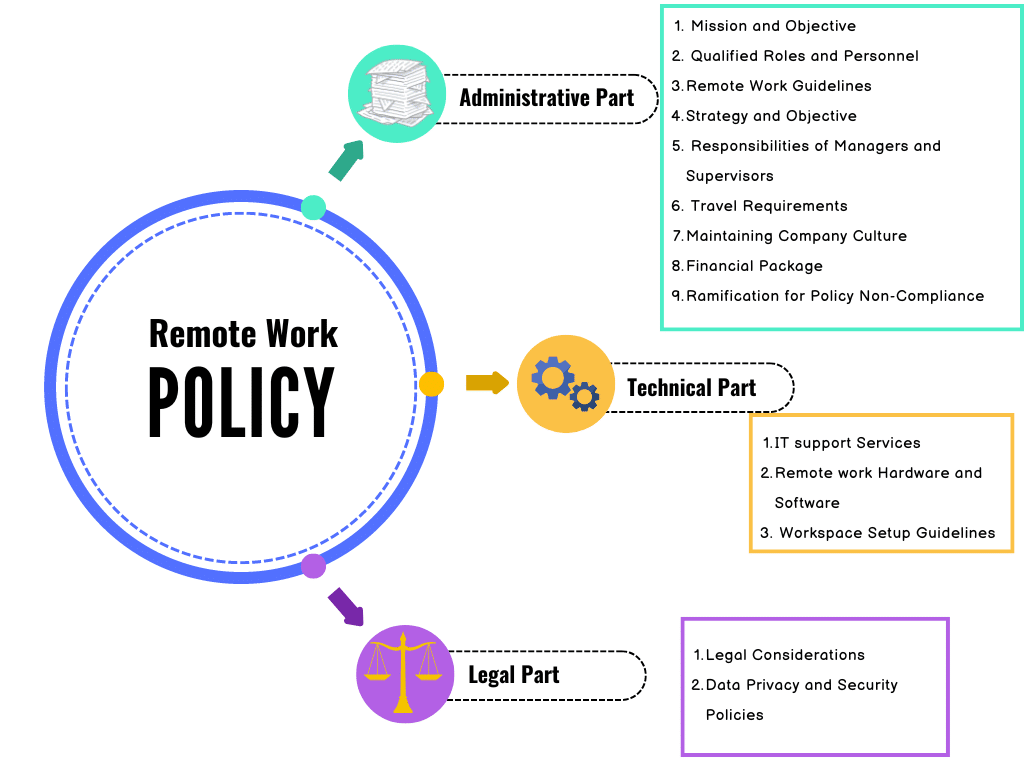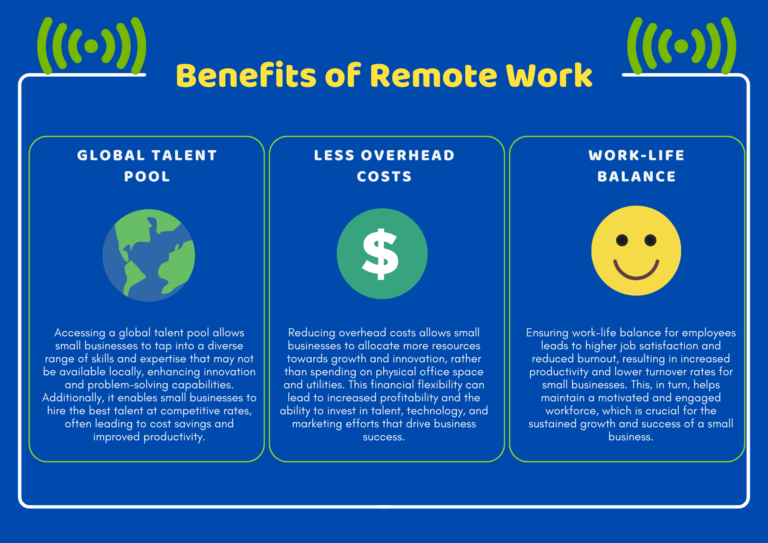Ultimate Guide to Creating an Effective Remote Work Policy for Your Business

Table of Contents
So, you are here, because you’ve decided that you should try remote work for your employees, but unsure as to how implement it with minimum loss for your company.
Of course, you also heard that it doesn’t work, people are not working and are less productive, even though we now have more researches that do show more productivity in a remote work environment.
Fear no more! With preparation and a well-defined Remote work policy and procedures, you will be able to enjoy and benefit from having remote employees.
Benefits of Remote Work and Why You Should Consider It
If you are not willing to learn and change, you probably should not implement remote work for your business, even though you will be missing on an opportunity to grow.
Let’s look over what benefits you do get from opening up to remote work.
First of all, you are no longer limited to a geographical location of your business. You can find your employee in a different state or even country. Of course, you will have to comply with local labor laws, which can be found online or if you are willing to spend some money, hire an attorney that can help you to navigate this part of remote work. Or use LegalShield. Most importantly, do not let this part to stop you in search of your next talented employee outside of your geographical location.
Then of course you have the overhead cost. You no longer need to rent the office at all, or you can downsize, or use work-sharing spaces if there is a need to meet your employees in person. You have different options available to you how to navigate this.
Third benefit is more for your employee rather than you, but when you have a happy employee, you will benefit as well. Work-life balance. There are studies conducted that shows that when your employee is happy, his or her work-life balance is…well, balanced, they are more productive and more attentive to your needs.
You can also read this study about strong leadership and remote work productivity to see how it is connected and why you need to educate your managers, or yourself, in order to benefit from off site environment.
Guidelines for Establishing an Effective Remote Work Policy
For all this to work properly, you will need to establish a comprehensive and tailored Policy for remote work. Think of it as your guideline, a plan, a map road to successfully implementing remote work.
The policy should have three different parts to it, the administrative, technological and legal . Not every single point that is mentioned in this guide will be relevant or needed for every small business, so if you feel like a point is irrelevant to you, you may skip it ahead, just make sure to reevaluate the policy every so often, because down the road that point might become important to you as well.

Let’s dive into the policy. First, I’m going to talk about what any business, small or corporate should have in it, then which parts a small business must have in order to succeed with remote work environment. Read the full version and I’m going to include an essential version for a small business owner, at the end, so that you understand what you need to include.
Administrative Part
Include here the mission statement of your business, clear objectives that you want to achieve, so that all stakeholders are aligned, benefits for your employees when working remotely, like enhanced work-life balance, enhanced productivity and ability to communicate and work with talent that is global.
Not every single position will be available for a remote work opportunity. Define criteria based on the nature of job responsibilities, the level of autonomy required, and the capability to perform tasks efficiently outside the traditional office setting. For example, someone who is working at the store, won’t be able to perform their duties at home.
You need to establish certain guidelines that remote employees should follow. For example, define when they should be available, responsiveness guidelines, and preferred communication channels. For instance, all of your employees are using Slack, or you have a WhatsApp group for work related questions. Encourage the use of video conference, like Zoom, or Teams, or any other video messenger that works for your company. Make sure that remote employees are check-in with their managers, colleagues, so that there is seamless communication between team members.
Align your company goals with the tasks and responsibilities that are part of your overall goal for your company objectives. Set deadlines and milestones that everyone needs to adhere to. For example, a remote team needs to provide statistics to your in-store team, so that they know which product they need to order.
To effectively lead and manage a remote team, managers and supervisors need to be trained how to manage a team that is not on site. It does require different mindset that what was common before. Encourage managers to develop their skills, through books, lectures or workshop to manage a remote team.
If your company requires travel, include here reimbursements policies and processes for business related expenses, any pre-approvals and documentation needed for reimbursement. For example, a receipt from hotel for the dates that the travel was needed, etc.
Maintaining company culture while working remotely can be difficult if you do not have a strategy to maintain it. Create activities, virtual or in person, if possible, to develop a sense of togetherness. Have a team outing day, so that the team can get to know each other better. Working off site can increase productivity, but it can also bring loneliness and a feeling of not belonging. Having a day off with all the members can help with that.
Like with all workers manuals, you should include financial package. Including compensations, health insurance, days off, sick days, retirements plans and other benefits. Include here if there are any differences from on-site employees.
Remote work should be considered a privilege not a given thing. Hence, why you should set a part where you describe the consequences for non-compliance. Describe actions the managers should take before revoking this privilege from an employee. Following this part in your Policy is very important.
Technical Part
In order to allow your employees smooth working environment, from IT point of view, you need to provide them with technical support, that is available to their disposal. This doesn’t necessarily mean that you need to have an IT person 24/7, though that it a really good idea, to have someone who can help to figure out an IT issue right away. You can also provide FAQs, or ask AI to create an FAQs for your company based on most common issues.
Here you can specify which tools and equipment your employees will need in order to perform their job in off-site setting. Consider providing a company- issued laptop or a desktop, with necessary software already installed and licenses provided, including project management tools, communication and collaboration tools, that your company is using.
Include guidelines how to create a proper workspace, that provides free from distractions environment and promotes focus and productivity and has suitable seating.
Legal Part
Take into consideration legal part of your policy, include labor laws relevant to remote work settings, how to count hours, overtime. Have your employees sign NDAs and NCAs. You may ask either a labor lawyer in your state, or you can sign up for a LegalShield to obtain a legal advice.
- Very important to have this in your policy. You need to set policies to protect your business information. Adhere to cybersecurity best practices, include password management, data encryption, secure file sharing, and outline consequence of any security breaches.
Short Remote Work Policy for Small Businesses: Essential Points
After reading this you might think to yourself that it’s too much work for you, or that it is unattainable because it requires too many things.
No worries, you don’t need to have everything if it doesn’t fit your company’s requirements.
For example, your company might be too small to include everything. Then simply exclude things that are not relevant to you. As I mentioned before, you should reevaluate the policy every so often, maybe at some point you will need to add things that were irrelevant to you before.
In my opinion, there are a few things that you do want to have for sure, and even there you can skip a few steps, but in order to move somewhere you do need to have a plan, or to evaluate if your remote work employees are doing their jobs.
So, what are the essential parts that you really can’t get away without when setting up a remote work policy?
Administrative part: Remote work guidelines, Strategy and Objective, Responsibilities of Managers and Supervisors, Ramification for Policy non-compliance.
Technical Part: For this part, you can skip the third one, workspace setup guideline, and if you can’t get a 24/7 IT guy, have someone from 9 to 5, and create really good FAQs that are easy to follow.
Legal Part: You really want to have everything here. After all, it is your business and you do want to protect yourself and your business.
Overall, if you have a plan, prepare yourself with setting policies and actually follow them, you can benefit from remote work.
Must-Read Books for Managing Remote Teams Effectively
This book, written by the founders of Basecamp, offers insights into the benefits and challenges of remote work, as well as practical advice on how to create and maintain a productive remote team environment.
This book provides a comprehensive guide to leading remote teams, covering key principles, practices, and techniques to enhance leadership effectiveness in a remote setting.
Pullan offers practical strategies and tools for leading virtual teams, focusing on communication, collaboration, and maintaining team engagement in a virtual environment.
Burkus explores the fundamental principles of managing remote teams, offering actionable insights on how to build trust, foster collaboration, and drive performance in a remote work setting.
This book provides a research-based approach to remote work, covering topics such as virtual collaboration, remote team management, and creating a remote work culture.
This book is a practical guide for remote work, covering everything from setting up a remote team to managing virtual meetings and maintaining team productivity.
Engaging Team-Building Activities for Remote Teams
Here are some of the examples of a team building activities you can use:
Schedule informal virtual coffee breaks where team members can chat about non-work-related topics. This helps build rapport and mimics the spontaneous conversations that happen in a physical office. Here you can find a few ideas as to how to conduct it.
Organize a trivia game using platforms like Kahoot! or Quizlet. Teams can compete against each other, fostering friendly competition and teamwork. Get a few ideas about virtual trivia games in this blog.
Participate in a virtual escape room where teams have to solve puzzles and clues to “escape” a virtual room within a time limit. This enhances problem-solving and collaboration skills. Start with this blog with ideas for a virtual escape rooms.
Start a book club where team members read the same book and meet virtually to discuss it. This can be a great way to connect over shared interests. You can read a bit more if you need in this blog.
Host a virtual happy hour where team members can relax and chat over drinks (non-alcoholic options included). You can include fun activities like themed dress codes or mixology sessions. This blog provides a really good overview of what to do during a virtual happy hour.
Each team member gets a few minutes to show and tell something interesting from their home or their personal life. This helps people get to know each other better. This is a fairly straight forward activity, however if you feel that you need a bit more information, this blog provides a good overview and suggestions how to conduct a virtual show and tell.
Either hire a professional chef or someone you know who knows how to cook and enjoys it, to lead a virtual cooking class where team members can cook the same meal together from their respective kitchens.
These activities can help build a sense of community and enhance team cohesion even when working remotely.
Conclusion
Crafting a tailored remote work policy and procedures is a transformative endeavor for small businesses. By embracing remote work, you open doors to unparalleled opportunities, including access to a global talent pool, reduced overhead costs, increased productivity, and improved work-life balance for your employees. This comprehensive guide has provided you with the necessary framework to create a unique and effective remote work policy that addresses the specific needs of your small business.
Remember, a well-defined remote work policy is just the beginning. Regularly review and update the policy to adapt to changing circumstances, technology advancements, and evolving industry practices. By nurturing a culture of trust, communication, and accountability, you can maximize the benefits of remote work and position your small business for long-term success in the modern work landscape.
If you require assistance in crafting a remote work policy tailored to your small business or have any questions regarding remote work implementation, our team at YMNIZA is here to support you. Reach out to us at [email protected]. Together, let’s unlock the full potential of remote work for your small business.
Share This Post
More To Explore

Effortless Integration: Unlocking the Power of Google Tag Manager for Your Website
Learn how to connect your website to Google Tag Manager (GTM) and streamline your marketing efforts for efficient, accurate, and flexible tracking of user interactions and website performance metrics




Hello! I hope you’re having a great day. Good luck 🙂
Hey people!!!!!
Good mood and good luck to everyone!!!!!